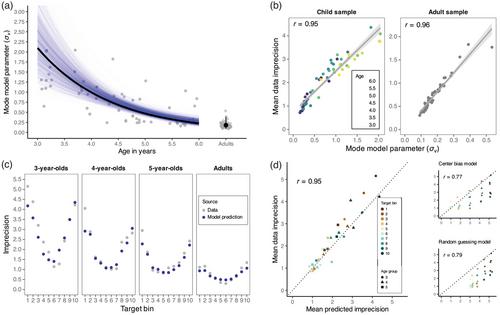Variation in gaze following across the life span: A process-level perspective
Abstract
Following eye gaze is fundamental for many social-cognitive abilities, for example, when judging what another agent can or cannot know. While the emergence of gaze following has been thoroughly studied on a group level, we know little about (a) the developmental trajectory beyond infancy and (b) the sources of individual differences. In Study 1, we examined gaze following across the lifespan (N = 478 3- to 19-year-olds from Leipzig, Germany; and N = 240 20- to 80-year-old international, remotely tested adults). We found a steep performance improvement during preschool years, in which children became more precise in locating the attentional focus of an agent. Precision levels then stayed comparably stable throughout adulthood with a minor decline toward old age. In Study 2, we formalized the process of gaze following in a computational cognitive model that allowed us to conceptualize individual differences in a psychologically meaningful way (N = 60 3- to 5-year-olds, 50 adults). According to our model, participants estimate pupil angles with varying levels of precision based on observing the pupil location within the agent's eyes. In Study 3, we empirically tested how gaze following relates to vector following in non-social settings and perspective-taking abilities (N = 102 4- to 5-year-olds). We found that gaze following is associated with both of these abilities but less so with other Theory of Mind tasks. This work illustrates how the combination of reliable measurement instruments and formal theoretical models allows us to explore the in(ter)dependence of core social-cognitive processes in greater detail.
Research Highlights
- Gaze following develops beyond infancy. The highest precision levels in localizing attentional foci are reached in young adulthood with a slight decrease towards old age.
- We present a computational model that describes gaze following as a process of estimating pupil angles and the corresponding gaze vectors.
- The model explains individual differences and recovers signature patterns in the data. To estimate the relation between gaze- and vector following, we designed a non-social vector following task.
- We found substantial correlations between gaze following and vector following, as well as Level 2 perspective-taking. Other Theory of Mind tasks did not correlate.


 求助内容:
求助内容: 应助结果提醒方式:
应助结果提醒方式:


